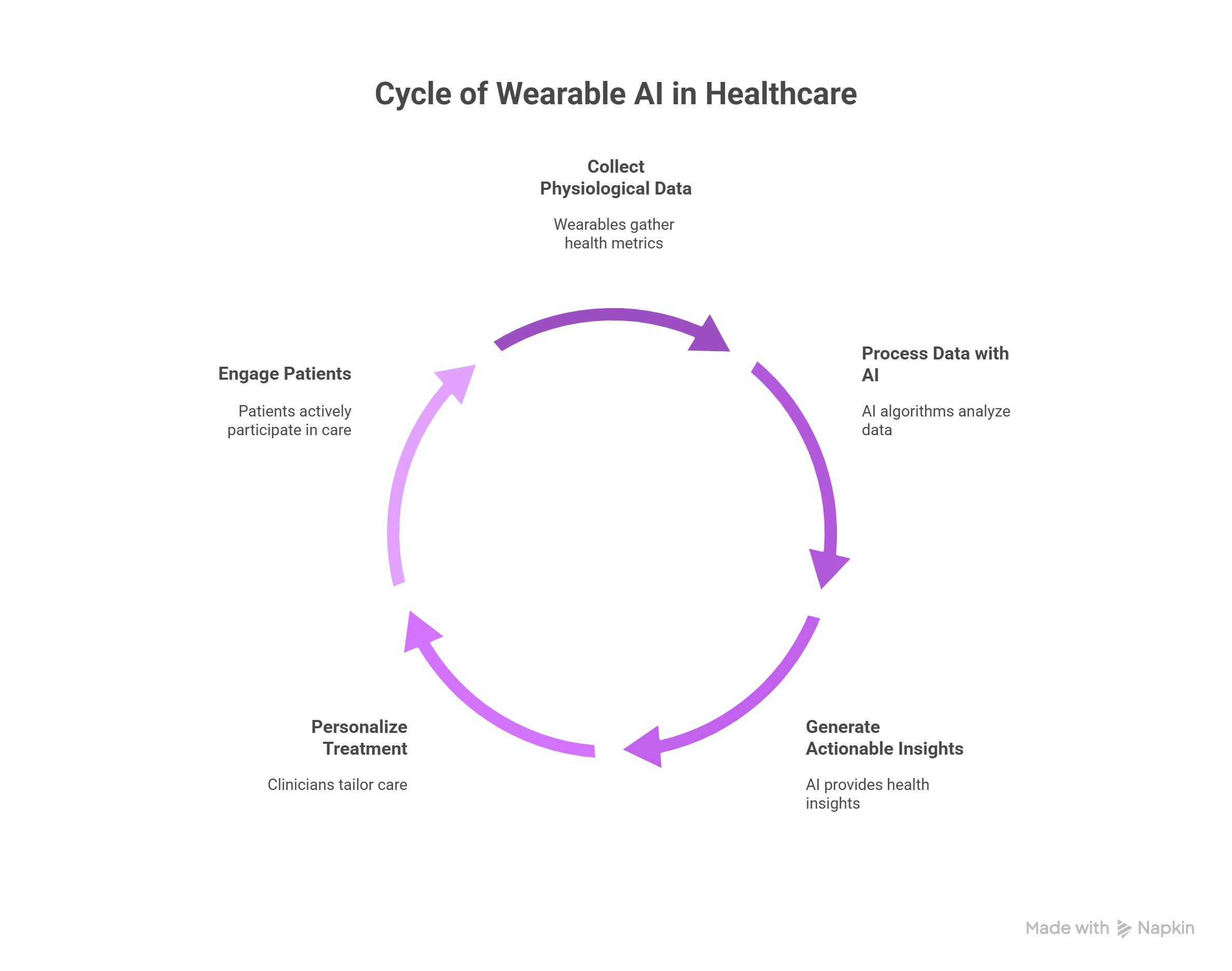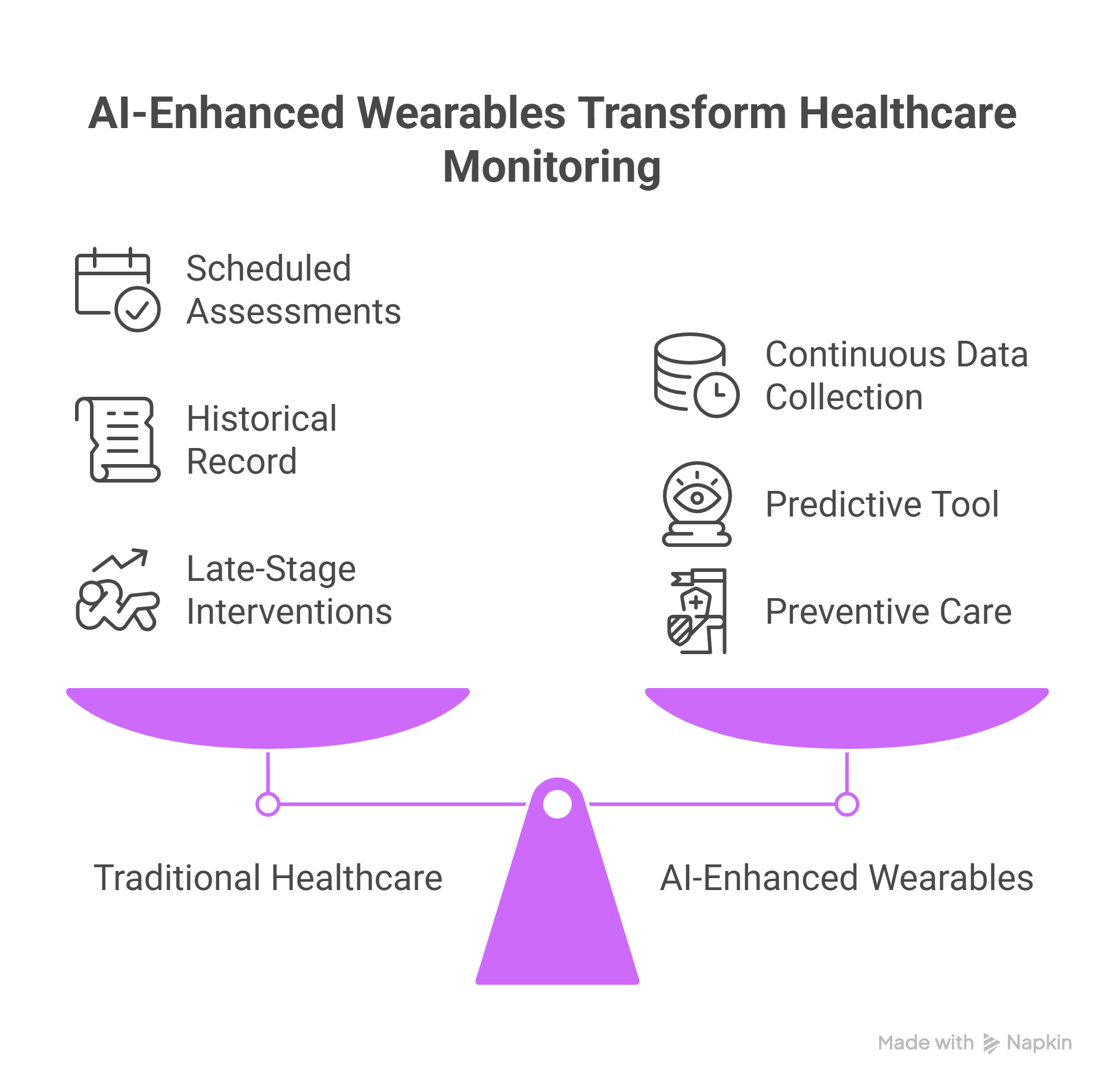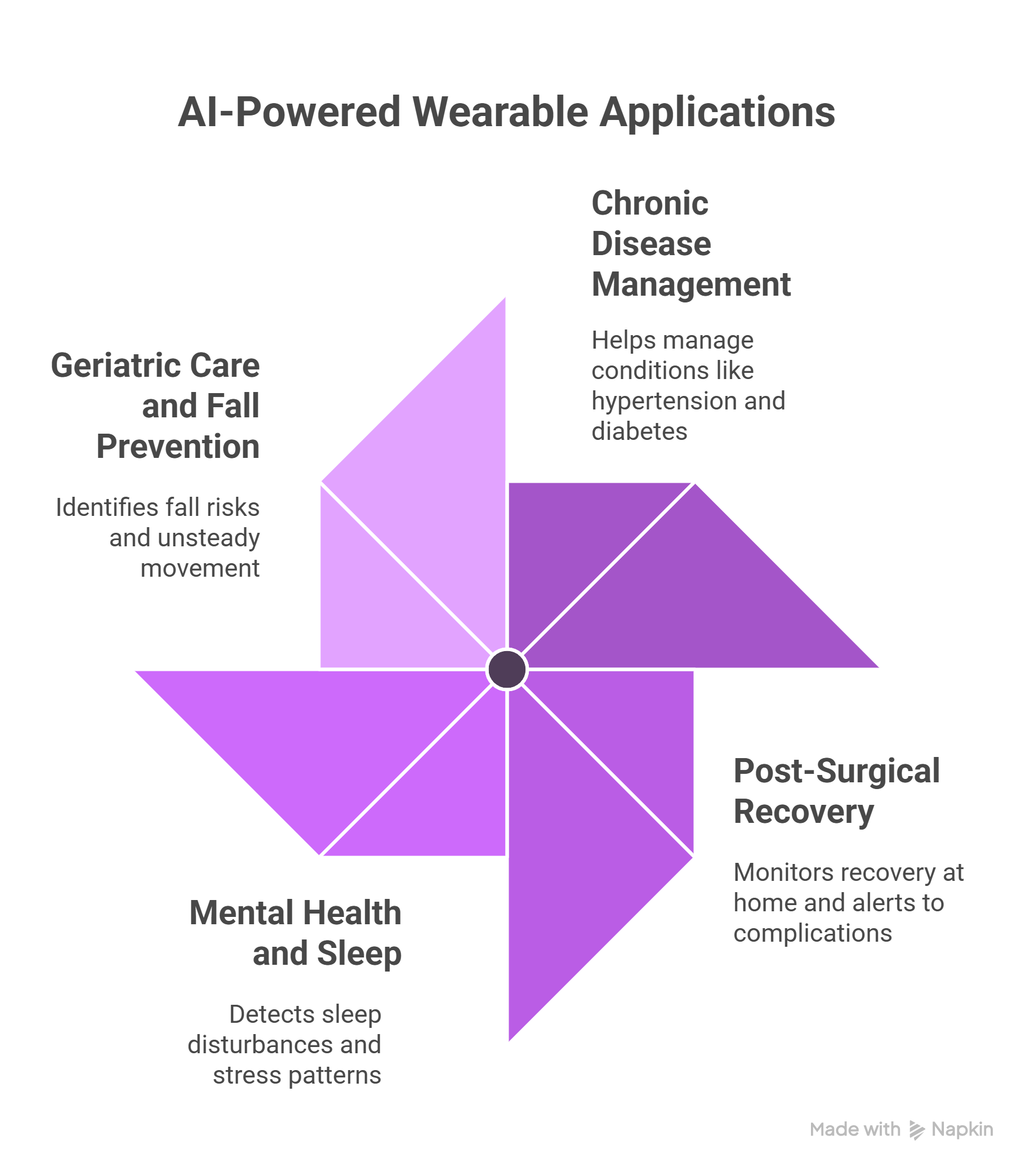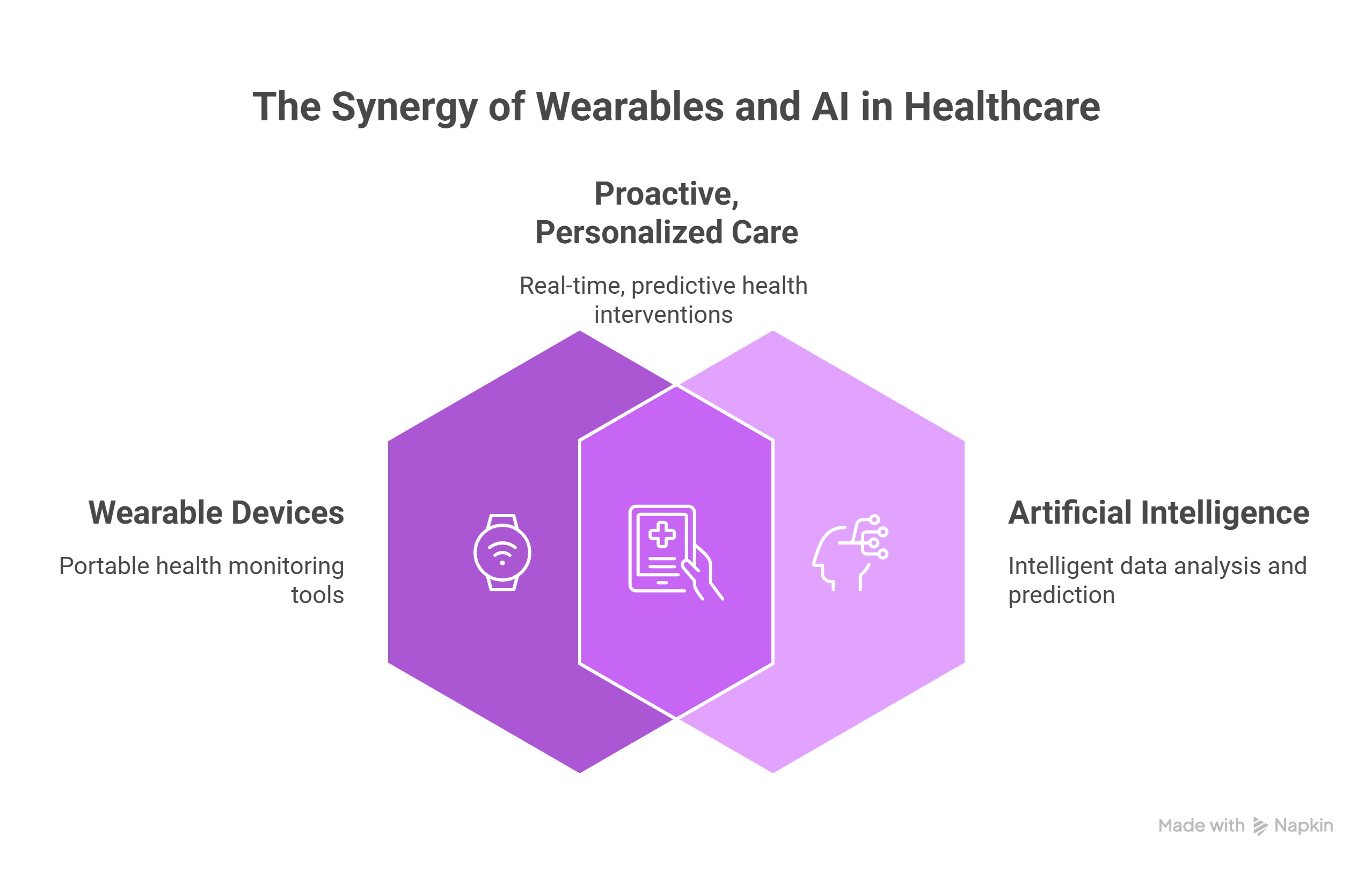How Are Wearables and AI Transforming Healthcare Monitoring?
The intersection of wearable technology and artificial intelligence (AI) is driving a fundamental shift in how healthcare providers track patient health. No longer confined to episodic check-ups or inpatient monitoring, continuous health surveillance is becoming the new standard, empowered by intelligent, connected devices.
Smartwatches, biosensors, and fitness bands now collect vast amounts of physiological data. AI algorithms then convert these raw signals into actionable insights. This combination is helping clinicians detect health changes earlier, personalize treatment, and keep patients engaged in their care.

What Makes Wearable AI Monitoring Different from Traditional Approaches?
Traditional healthcare relies on scheduled assessments and patient self-reporting. In contrast, wearable devices collect data passively, around the clock. Heart rate, oxygen saturation, movement, glucose levels, and sleep patterns are monitored in real time. When paired with AI, this data becomes a predictive tool, not just a historical record.
Machine learning models identify anomalies, uncover trends, and alert care teams before symptoms escalate. AI also adapts to individual baselines, making insights more precise. This enables truly preventive care instead of late-stage interventions.
Which Wearable Technologies Are Leading Continuous Monitoring?
Advancements in sensor miniaturization and wireless connectivity have expanded the reach of wearable health tools. Smartwatches and fitness bands are widely used to track activity, heart rate, sleep, and stress. ECG patches provide long-term heart rhythm monitoring, while continuous glucose monitors (CGMs) deliver real-time glucose levels for diabetes management. Wearable pulse oximeters are used to measure oxygen saturation during activity or sleep. Smart clothing and insoles monitor posture, gait, or muscle activity, offering support for rehabilitation and mobility.
These tools often sync with mobile apps and cloud platforms, enabling clinicians to remotely view dashboards, receive alerts, and review longitudinal data trends.
How Does AI Make Wearables Smarter?
AI amplifies the value of wearable data by detecting subtle trends that would otherwise go unnoticed. It supports anomaly detection by identifying deviations in vitals that may signal deterioration. Predictive modeling anticipates exacerbations in chronic conditions like asthma or heart failure. Behavioral insights emerge by correlating physical activity, sleep, and nutrition with health outcomes. Personalized feedback delivers tailored recommendations to patients for self-care.
AI can also help reduce false positives by learning what is normal for each patient, minimizing alert fatigue for both users and clinicians.
Where Is Wearable AI Being Used Most Effectively?
In chronic disease management, patients with hypertension, diabetes, COPD, and cardiac arrhythmias benefit significantly. Real-time data helps adjust medications, flag warning signs, and reinforce adherence.
During post-surgical recovery, wearables track mobility, pain levels, and vital signs during recovery at home. AI alerts providers to early signs of complications such as infection or immobility.
For mental health and sleep, devices detect sleep disturbances, stress patterns, and mood-related metrics. AI interprets these for therapists or mental health platforms, supporting personalized interventions.
In geriatric care and fall prevention, motion and balance sensors help identify fall risk or detect unsteady movement. AI analyzes gait patterns to alert caregivers and inform preventive strategies.
What Are the Benefits of AI-Enhanced Wearable Monitoring?
Patients benefit from early detection of health changes, empowerment through self-monitoring, fewer in-person appointments, and a better understanding of their health.
Clinicians gain timely and contextual patient data, reduce unnecessary visits and tests, improve adherence and outcomes, and have more time for high-risk cases.
Healthcare systems see reduced hospital readmissions, cost savings from preventive care, better resource allocation, and improved population health analytics.
What Challenges Need to Be Overcome?
Despite rapid growth, wearable AI monitoring faces barriers. Data overload can overwhelm clinicians when too much unfiltered information is generated. Integration with electronic health records and clinical systems remains a challenge. Algorithm transparency is essential to build clinician trust in AI recommendations. Privacy concerns must be addressed as patients expect control over their personal data. User compliance is also key; devices must be comfortable, reliable, and easy to use.
How Is John Snow Labs Supporting the Wearable AI Ecosystem?
John Snow Labs provides the AI infrastructure needed to turn wearable data into clinically useful insights.
Healthcare NLP extracts context from patient notes and correlates it with wearable metrics. Medical large language models interpret unstructured inputs, help generate AI-driven care plans and provide with a natural language interface when querying timeseries information registered by wearables.
These solutions bridge gaps between raw sensor data and clinical decisions, enabling more holistic patient understanding.
What’s Next for AI and Wearable Monitoring?
As sensor capabilities advance and edge computing matures, we’ll see more real-time AI processing directly on devices. This reduces latency, enhances privacy, and supports monitoring in underserved or remote settings.
Multimodal models will combine voice, image, text, and sensor data for comprehensive diagnostics. Federated learning will enable privacy-preserving AI model training across institutions, improving both personalization and generalization.
Conclusion: Why the Future of Monitoring Is Wearable and Intelligent
Wearable devices, once used for fitness, now serve as powerful clinical decision support tools. When paired with AI, they enable continuous, contextual care that is proactive rather than reactive. This evolution supports better patient outcomes, more efficient care delivery, and healthier populations.
Healthcare organizations that integrate wearable AI now will be best positioned to lead in preventive, personalized care.
FAQs
How accurate are wearable health devices? Many modern wearables meet clinical-grade accuracy standards for specific metrics like ECG, heart rate, and glucose levels. Validation varies by device type and use case.
Can AI replace doctors in monitoring? AI supports, but does not replace, clinical judgment. It helps prioritize alerts and detect trends, but care decisions remain with providers.
Are wearable devices safe and private? Data encryption, regulatory compliance, and user consent mechanisms help protect privacy. Choosing HIPAA-compliant vendors is essential.
How can hospitals use wearable data effectively? By integrating wearable data into clinical systems and combining it with NLP and AI tools, hospitals can enable early interventions and continuous risk assessment.
What makes John Snow Labs unique in this space? John Snow Labs provides healthcare-specific AI tools that enable real-time, explainable insights from structured and unstructured data, ensuring wearable monitoring leads to actionable outcomes.
































